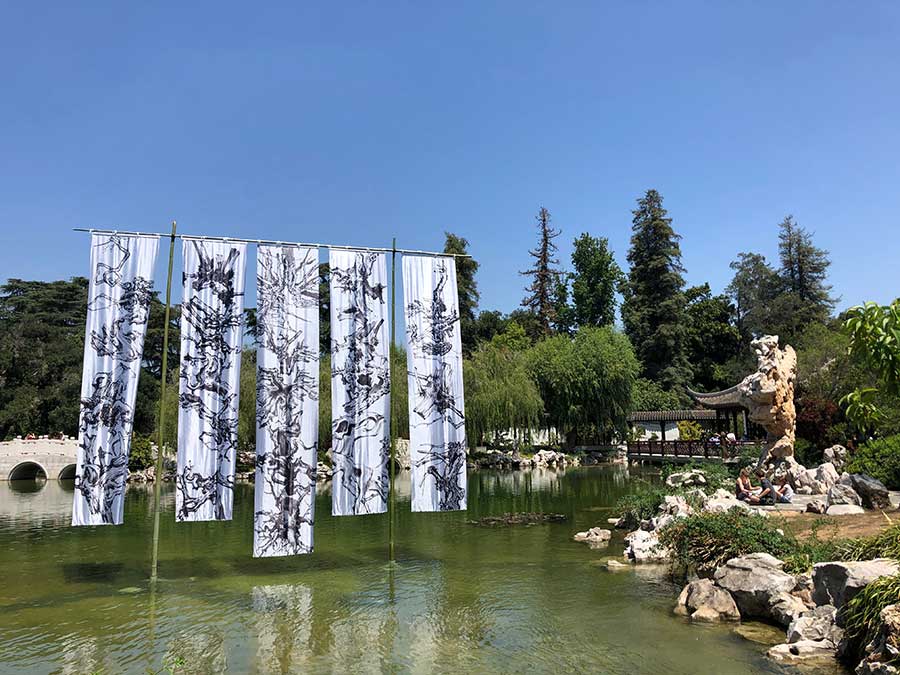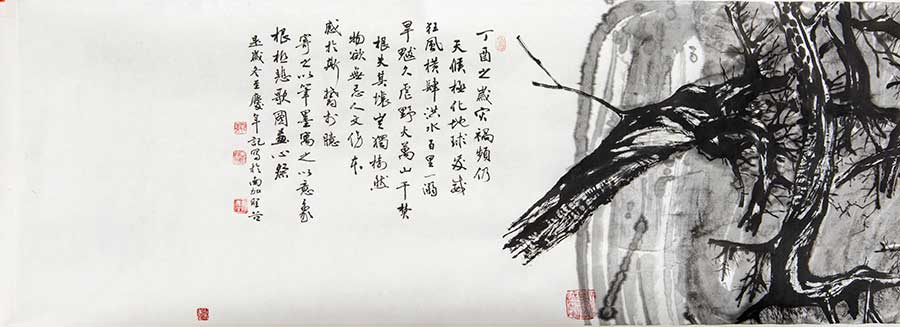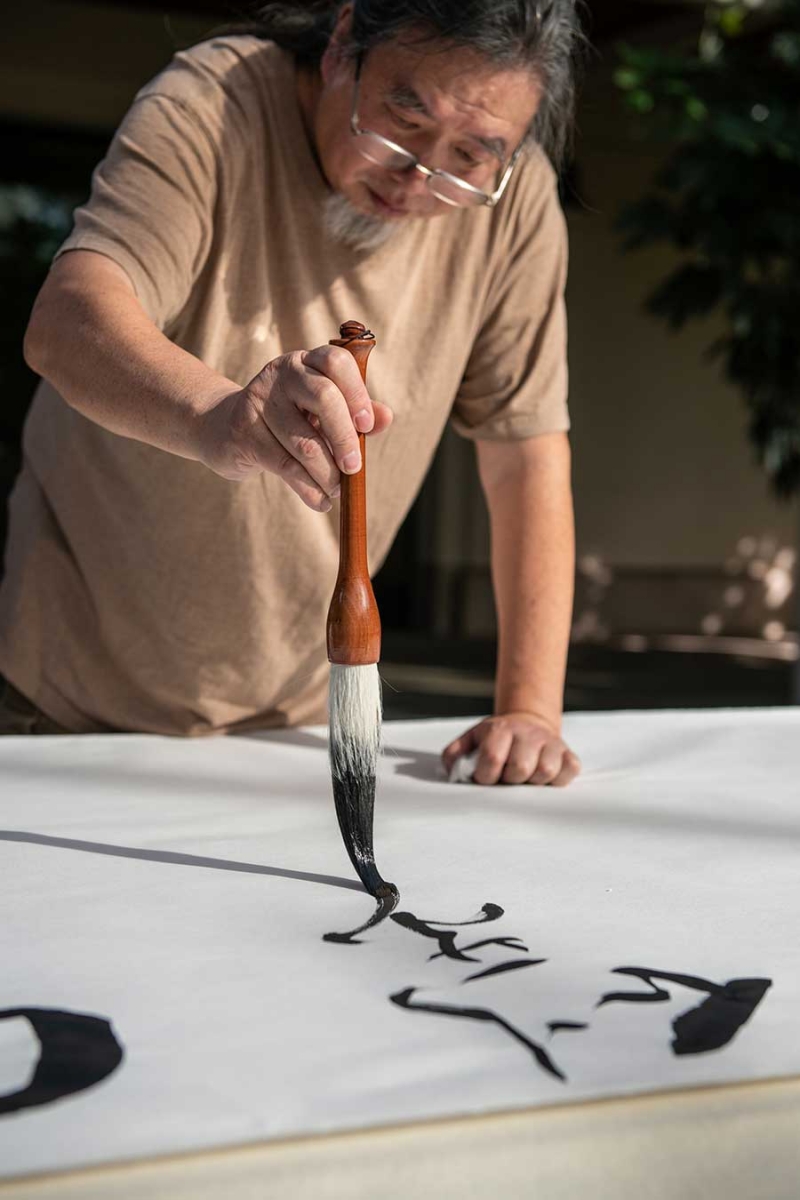The Huntington’s blog takes you behind the scenes for a scholarly view of the collections.
An Offering to Roots
Posted on Wed., July 10, 2019 by

Tang Qingnian 唐慶年, born 1956, Chinese and American. An Offering to Roots 根之祭, 2017–2019. Five panels, digital print on nylon. Courtesy of the artist. Photo by Lucy Spriggs.
An art installation unlike any The Huntington has displayed before is now on view in the Chinese Garden (Liu Fang Yuan 流芳園, or the Garden of Flowing Fragrance). Reproductions of five monumental banner paintings by Tang Qingnian 唐慶年, suspended from a bamboo framework, are wafting in the breeze above the garden's lake.
Two years in the making, the ink paintings—the largest are 18 feet long—memorialize the devastating wild fires that ravaged California in 2017 and 2018. Withered trees, tumbling through ambiguous spaces that evoke fiery winds or furious hurricanes, appear simultaneously as dead root balls and as ecstatic fireworks, sparking with life.
Tang, the 2019 Cheng Family Foundation Artist-in-Residence in the Chinese Garden, observed the fires, the most destructive in California’s history, from his home in Pasadena. He felt compelled to respond to these terrifying manifestations of climate change through An Offering to Roots 根之祭, a series of works combining painting and calligraphy. Original handscrolls and albums by Tang, on display in the garden’s Waveless Boat Pavilion, complement the huge banner paintings and illuminate the artist’s process.
Video showing the banner paintings of An Offering to Roots waving in the breeze next to the Waveless Boat Pavilion.
Such a contemporary subject may seem surprising in the context of the Chinese Garden, but Phillip E. Bloom, the June and Simon K. C. Li Curator of the Chinese Garden and director of the Center of East Asian Garden Studies, explains: “One of the oldest traditions of a classical scholar’s garden is to inspire artistic and literary creativity. Displaying new work is entirely in keeping with that aesthetic tradition.”
Tang found a key link between his reaction to the fires and that tradition in the poem “Rhapsody on a Barren Tree” by Yu Xin (513–581). “I knew of that poem,” says Tang, “but, when I read it carefully, I realized my thoughts matched his.”
In 2017, Tang made a 38-foot handscroll illustrating the poem; the handscroll is now on view in the Waveless Boat Pavilion. It is open to the final scene, containing Tang’s colophon (in this instance, an artist’s statement) composed in classical Chinese and translated and excerpted here: “…Tree roots lost their grip—after all, they are but plants. Though things like trees seek to live without fear, humanity harms their core. Moved by this, despondency welling in my chest, I transmitted my thoughts with brush and ink, confiding through images—an elegy for roots, an offering of pictures.”

Tang Qingnian 唐慶年, born 1956, Chinese and American. Detail of Illustrations to the Rhapsody on a Barren Tree, 2017. Handscroll, ink, and light color paper. Courtesy of the artist. Tang's colophon, composed in classical Chinese, appears in this final scene of the 38-foot handscroll.
Bloom points out that, for centuries, dying trees provided Chinese poets and artists with evocative metaphors for the tragedies of human life. He believes Tang has revitalized this tradition with An Offering to Roots. According to Bloom, the work also reflects Tang's position as an immigrant artist who is separated, but not completely, from his roots: "Tang was born in China, but he works in the United States. He employs the materials of traditional Chinese painting but uses a modern visual language," says Bloom.
Full-size prints of Tang's original banner paintings have been reproduced on silk-like nylon fabric. The grand proportions of the prints and how to display them to best advantage in the Chinese Garden challenged The Huntington's team in charge of the installation, led by Tang, Bloom, and Andrew Mitchell, the Botanical Division's curator of material objects. How should they suspend the prints over the lake, allowing them to move and yet providing them with a stable base?
Bamboo was deemed suitable for the framework, both artistically and structurally. Mitchell had used timber bamboo similarly for events in the Japanese Garden and knew it would be strong as well as flexible enough and withstand the wind. The bamboo for An Offering to Roots was harvested from The Huntington.

Tang Qingnian 唐慶年, the 2019 Cheng Family Foundation Artist-in-Residence at The Huntington. Photo by Jamie Pham. The Huntington Library, Art Collections, and Botanical Gardens.
The framework rests on heavy steel piers. By chance, the draining of the garden’s lake to repair its biofilter coincided with the placing of the piers, which would have been more difficult to install with the lake full.
Tang’s images of barren trees, pulsing in the breeze, invite viewers to contemplate the questions they provoke and the lessons they offer.
Tang Qingnian will demonstrate the art of Chinese calligraphy and discuss “An Offering to Roots” with curator Phillip E. Bloom on Sunday, July 14, at 2:30 p.m. in the Chinese Garden.
“Tang Qingnian: An Offering to Roots” is on display in The Huntington’s Chinese Garden through September 23, 2019.
The Liu Fang Yuan Artist-in-Residence program is supported by the Cheng Family Foundation. This installation was made possible by Chase Private Client.
Linda Chiavaroli is a volunteer in the Office of Communications and Marketing at The Huntington.